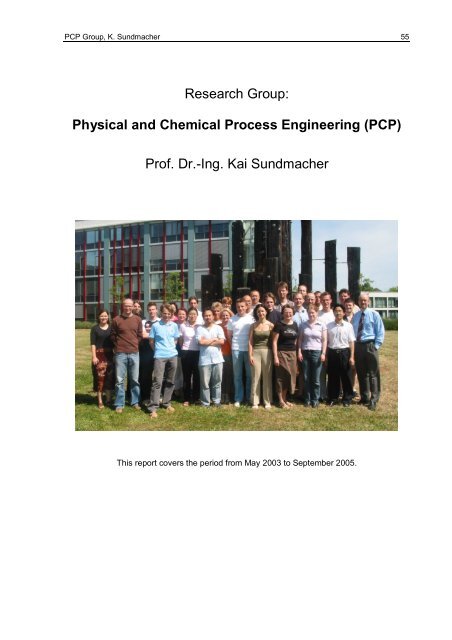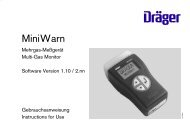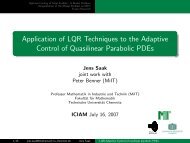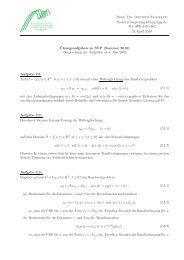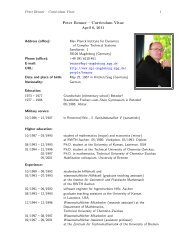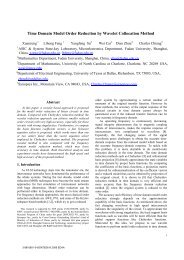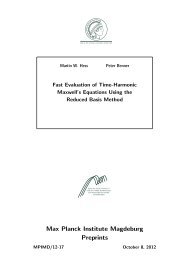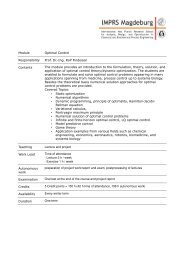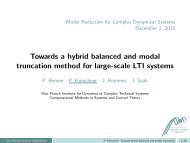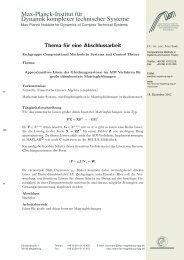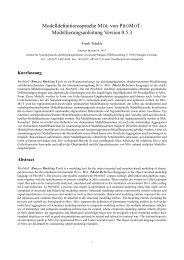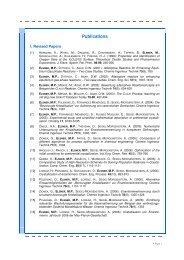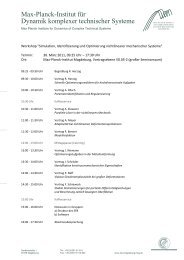Physical and Chemical Process Engineering - Max Planck Institute ...
Physical and Chemical Process Engineering - Max Planck Institute ...
Physical and Chemical Process Engineering - Max Planck Institute ...
Create successful ePaper yourself
Turn your PDF publications into a flip-book with our unique Google optimized e-Paper software.
PCP Group, K. Sundmacher 55<br />
Research Group:<br />
<strong>Physical</strong> <strong>and</strong> <strong>Chemical</strong> <strong>Process</strong> <strong>Engineering</strong> (PCP)<br />
Prof. Dr.-Ing. Kai Sundmacher<br />
This report covers the period from May 2003 to September 2005.
56<br />
1 Group Introduction<br />
The research of the <strong>Physical</strong> <strong>and</strong> <strong>Chemical</strong> <strong>Process</strong> <strong>Engineering</strong> (PCP) group covers<br />
the design, operation <strong>and</strong> analysis of complex chemical processes. The primary<br />
focus is on the system-orientated analysis of all physical <strong>and</strong> chemical phenomena<br />
involved <strong>and</strong> their interactions in hierarchical time <strong>and</strong> length scales. In particular,<br />
PCP focuses on the quantitative characterization <strong>and</strong> description of the physical <strong>and</strong><br />
chemical transport phenomena. Additional attention is paid to the analysis of the<br />
nonlinear dynamic behavior of the processes <strong>and</strong> systems under investigation.<br />
Therefore, methods of mathematical modeling <strong>and</strong> simulation are closely combined<br />
with experimental concepts for model validation.<br />
The current research activities of the PCP group are located in four MPI project areas<br />
(see figure 1 in section 3). Within the project area Integrated <strong>Process</strong>es, the group’s<br />
research is focused on studying reactive separations, fuel cells <strong>and</strong> membrane<br />
reactors. For the model-based analysis of fuel cells, hierarchical modeling strategies<br />
were developed <strong>and</strong> a virtual fuel cell laboratory was set up within the project area<br />
Network Theory. A novel reactor concept for the production of pure hydrogen for<br />
fuel cells in a periodically operated multi-bed steam reformer is analyzed in the<br />
project area Hybrid <strong>and</strong> Discrete Event Systems. Last, but not least, in full<br />
accordance to the SAB recommendations of the evaluation in 2003, the PCP group<br />
has intensified its research activities within the project area Population Balance<br />
Systems. Using nanoparticle precipitation processes in bulk solutions <strong>and</strong> emulsions<br />
as examples, multidimensional population balances were solved <strong>and</strong> Monte-Carlo<br />
methods were established to analyze the dynamics of the considered particulate<br />
systems. In all four research areas, collaborative projects with other MPI groups<br />
(PSD, SCT, PCF, BPE) were established, thereby using the institute’s system<br />
science concept as common umbrella.<br />
Since 2001, Kai Sundmacher, being the Director for <strong>Process</strong> <strong>Engineering</strong> at the MPI,<br />
has guided the research activities of the PCP group <strong>and</strong> the university chair for<br />
<strong>Process</strong> Systems <strong>Engineering</strong> (PSE) at the Otto-von-Guericke University Magdeburg<br />
(OvGU), simultaneously. Both groups collaborate intensively, which is reflected in a<br />
number of common research projects.
PCP Group, K. Sundmacher 57<br />
2 Members of the Research Group<br />
As of September 30 th 2005, the group consisted of eight scientists with Ph.D.<br />
degrees <strong>and</strong> 11 graduate students working towards a Ph.D. During 2003-2005 two<br />
group members received their Ph.D. degree <strong>and</strong> six additional Ph.D. students have<br />
submitted their dissertations to the Otto-von-Guericke University Magdeburg. The<br />
defenses will take place in the next few months (see also Table 3). Since 2003, the<br />
group has published about 50 articles to international scientific journals.<br />
Nearly all scientists of the PCP group work in non-permanent positions. The only<br />
permanent position is held by Dr. Rihko-Struckmann who – in addition to her<br />
research activities – is responsible for the co-ordination of the group’s technical staff.<br />
This staff consists of two process engineers <strong>and</strong> two laboratory coworkers who<br />
support the PCP scientists, regardless which special research topic is addressed.<br />
Furthermore, the research is supported by several undergraduate students from the<br />
OvGU who are currently working on their master/diploma theses.<br />
At the university, currently six Ph.D. students are preparing their dissertation theses.<br />
All of them are engaged in topics which have direct links to MPI research projects.<br />
Furthermore, one postdoctoral researcher (Dr. Voigt) completes the scientific work<br />
group under the direction of the university. All scientists are supported by E. Felsch<br />
who is responsible for the chair’s preparative <strong>and</strong> analytical chemistry.<br />
Tab. 1: Composition of PCP group<br />
Head of Group<br />
Prof. Dr.<br />
K. Sundmacher<br />
Postdocs<br />
Research Topics Membership<br />
Reactive separations, fuel cells, electrochemical<br />
membrane processes, population balance<br />
systems: modeling, analysis, design, experimental<br />
validation<br />
since 10/1998<br />
Dr. H. Freund Integrated processes: modeling, analysis since 09/2005<br />
Dr. V. Galvita<br />
Fuel cells, reforming: process/catalyst<br />
development<br />
since 09/2002<br />
Dr. P. Heidebrecht Fuel cells, reforming: modeling, optimization since 09/2005<br />
Dr. Z. Qi<br />
Dr. L.K. Rihko-<br />
Struckmann<br />
Reactive separation: modeling, nonlinear<br />
dynamics<br />
Electrochemical membrane reactors: experimental<br />
analysis; Co-ordination of the group’s technical<br />
staff<br />
since 09/1999<br />
since 01/2001
58<br />
Dr. T. Schultz Fuel cells, membranes: modeling, exp. analysis since 05/1999<br />
Dr. A. Voigt Particulate precipitation: Monte-Carlo simulation 11/2003 - 08/2005<br />
Dr. E. Yu Enzymatic fuel cells: experimental analysis since 01/2005<br />
Ph.D. Students<br />
R. Hanke-<br />
Rauschenbach<br />
PEM fuel cells: modeling, nonlinear dynamics since 11/2001<br />
Y.S. Huang Reactive membrane separation: modeling since 11/2001<br />
J. Koch Population balances: numerical algorithms since 06/2004<br />
U. Krewer Direct Methanol Fuel Cell: modeling, analysis 10/2001 - 10/2005<br />
B. Munder Electrochemical membrane reactors: modeling since 04/2001<br />
B. Niemann Nanoparticle precipitation: population balances since 10/2002<br />
F. Rauscher Nanoparticle precipitation: experimental analysis 04/2001 - 08/2005<br />
Y. Song Direct Methanol Fuel Cell: fluid dynamics since 06/2001<br />
F. Steyer Reactive distillation: modeling, exp. analysis 06/2000 - 09/2005<br />
T. Vidakovic Fuel cells electrode kinetics: experimental analysis 07/2002 - 09/2004<br />
Y. Ye Electrochemical membrane reactors: exp. analysis 11/2001 - 08/2005<br />
Visiting Scientists<br />
Prof. Dr.<br />
M. Christov<br />
Prof. Dr.<br />
P. Hasal<br />
Prof. Dr.<br />
S. Mahajani<br />
Prof. Dr.<br />
D. Ramkrishna<br />
Prof. Dr.<br />
E.U. Schlünder<br />
Technical Staff<br />
C. Fuchs<br />
T. Schröder<br />
P. Siegmund<br />
B. Stein<br />
Guest professor from UCTM Sofia: Electrochemistry<br />
of fuel cells, modeling, experimental analysis<br />
Visiting professor from ICT Prague: Electromembrane<br />
processes (within BMBF/WTZ project)<br />
Visiting professor from IIT Bombay: Reactive<br />
separation (within VW-Foundation project)<br />
Visiting professor from Purdue University: Population<br />
balance modeling (Humboldt award fellow)<br />
Honorary scientist from Uni Karlsruhe: Reactive<br />
membrane processes, modeling, exp. analysis<br />
Laboratory assistant: fuel cells, electrode <strong>and</strong><br />
catalyst preparation, chemical analytics<br />
Laboratory engineer:plant design <strong>and</strong> operation,<br />
safety issues, maintenance<br />
Laboratory engineer: plant design <strong>and</strong> operation,<br />
safety issues, maintenance<br />
Laboratory assistant: separation processes,<br />
particulate processes, chemical analytics<br />
Group at OvGU: <strong>Process</strong> Systems <strong>Engineering</strong><br />
09/2003-02/2004<br />
10/2004-01/2004<br />
several visits of<br />
1-2 weeks<br />
several visits of<br />
1-2 weeks<br />
several visits of<br />
1-2 weeks<br />
since 04/2000<br />
since 04/2004<br />
since 01/2002<br />
since 02/2003<br />
since 10/2001<br />
Ph.D. Students: D. Adityawarman, L. Chalakov, M. Gundermann, M. Ivanova, M. Pfafferodt,<br />
C. Steyer, Postdoc: Dr. A. Voigt, Laboratory Coworker: E. Felsch
PCP Group, K. Sundmacher 59<br />
3 Research Highlights<br />
The current research projects of the PCP group are illustrated in Fig.1. More detailed<br />
information is collected in Table 2 where the projects are classified according to the<br />
project area structure established by the MPI. Most of the PCP projects are<br />
performed in close collaboration with other MPI groups <strong>and</strong>/or external partners at<br />
universities <strong>and</strong> research institutions. Since the PCP group interacts strongly with the<br />
<strong>Process</strong> Systems <strong>Engineering</strong> (PSE) group at Otto-von-Guericke University<br />
Magdeburg, a significant number of the listed subprojects are carried out in<br />
collaboration with PSE scientists.<br />
Fig.1: Survey of PCP research areas <strong>and</strong> projects (* = scientific coworkers of the group <strong>Process</strong> Systems<br />
<strong>Engineering</strong> at Otto-von-Guericke University Magdeburg, OvGU)
60<br />
Tab. 2: Survey of research projects of PCP group (* Members of the OvGU group)<br />
Project Area: Integrated <strong>Process</strong>es<br />
Project:<br />
Reactive Distillation <strong>and</strong><br />
Membrane Separation<br />
A reactive distillation process combines reaction <strong>and</strong><br />
distillation in one single unit. The benefits of this<br />
approach can be lower energy consumption <strong>and</strong> a<br />
reduction in the number of process units. However, the<br />
combination also results in a more complex process<br />
behavior. A detailed analysis of this behavior is the<br />
subject of this project. The PCP group activities are<br />
focused on the analysis of<br />
• the nonlinear process behavior,<br />
• reaction mixtures exhibiting liquid phase instabilities,<br />
• coupled reactions in combination with separation,<br />
• the influence of membranes on the feasible product<br />
spectrum of a reactive separation process,<br />
• micro-units being used for reactive separation.<br />
Subprojects Scientists Funded by Start Partners<br />
Feasibility analysis of<br />
reactive distillation processes<br />
Reactive distillation with<br />
liquid phase splitting<br />
Coupling of chemical reactions in<br />
a reactive distillation process<br />
Reactive membrane separation<br />
Qi MPI 09/1999<br />
F. Steyer,<br />
Qi<br />
Ivanova*,<br />
Qi<br />
Huang,<br />
Schlünder<br />
MPI 09/1999<br />
VW,<br />
OvGU,<br />
MPI<br />
01/2001<br />
SCT Group<br />
(Flockerzi)<br />
PSD Group<br />
(Radulescu),<br />
SCT Group<br />
(Flockerzi),<br />
Companies:<br />
Oxeno, Degussa<br />
IIT Bombay<br />
(Prof. Mahajani,<br />
Prof. Aghalayam)<br />
MPI 11/2001 PSD Group<br />
(Mangold)<br />
Reactive micro-separators Schultz MPI 01/2005<br />
Project:<br />
Low-Temperature Fuel Cells<br />
PSD Group<br />
(Zeyer)<br />
This project is focused on the analysis of the complex<br />
interaction of reaction <strong>and</strong> transport phenomena<br />
involved in low-temperature fuel cells processes. The<br />
investigated types of cells are PEM Fuel Cells (PEMFC),<br />
Direct Methanol Fuel Cells (DMFC) <strong>and</strong> Enzymatic Fuel<br />
Cells. The objectives are<br />
• to analyze the input-output behavior to these fuel cell<br />
systems with respect to dynamic load changes,<br />
• to develop reliable, i.e. validated process models for<br />
all sub-units of a fuel cell (electrodes, membrane,<br />
manifolds, single cells, cell stacks) <strong>and</strong><br />
• to derive reduced process models for control<br />
purposes.<br />
Subprojects Scientists Funded by Start Partners<br />
Experimental <strong>and</strong> model-based<br />
analysis of DMFC dynamics<br />
Schultz,<br />
Krewer<br />
MPI 05/1999<br />
Uni Karlsruhe<br />
(Prof. Kind),<br />
OvGU<br />
(Prof. Hauptmann)
PCP Group, K. Sundmacher 61<br />
Analysis of DMFC electrode<br />
kinetics<br />
Computational fluid dynamics<br />
of fuel cells<br />
Nonlinear dynamics of<br />
PEM fuel cells<br />
Integration of fuel cells with<br />
electro-membrane reactors<br />
Vidakovic,<br />
Krewer,<br />
Christov,<br />
Schultz<br />
Pfafferodt*,<br />
Song,<br />
Krewer<br />
Hanke-<br />
Rauschenbach<br />
MPI 07/2002<br />
OvGU<br />
MPI<br />
06/2001<br />
MPI 01/2002<br />
Schultz BMBF 01/2003<br />
Enzymatic fuel cells Yu MPI 01/2005<br />
Project:<br />
High-Temperature Fuel Cells<br />
MPI for Coal<br />
Research<br />
(Prof. Bönnemann)<br />
OvGU<br />
(Prof.Thévenin,<br />
Prof. Tobiska)<br />
PSD Group<br />
(Mangold)<br />
ICT Prague<br />
(Prof. Hasal)<br />
BPE Group<br />
(Genzel)<br />
The Molten Carbonate Fuel Cell (MCFC) is a high<br />
temperature fuel cell which permits internal steam<br />
reforming of methane. Appropriate process models are<br />
being developed <strong>and</strong> validated experimentally. Based<br />
on this, model-based observers can be designed <strong>and</strong><br />
tested. The PCP group is involved in the development<br />
of fuel cell models <strong>and</strong> the experimental validation<br />
studies at a 300 kW MCFC power plant. Furthermore,<br />
the nonlinear process behaviour of these hightemperature<br />
fuel cells is analyzed theoretically.<br />
Subprojects Scientists Funded by Start Partners<br />
Model-based analysis of<br />
DIR-MCFC processes<br />
Experimental model validation of<br />
a large scale DIR-MCFC<br />
Nonlinear analysis of hightemperature<br />
fuel cells<br />
Heidebrecht,<br />
Pfafferodt*<br />
OvGU 01/2001<br />
Gundermann*,<br />
BMBF 05/2002<br />
Heidebrecht<br />
Sundmacher MPI 01/2004<br />
PSD Group<br />
(Mangold),<br />
Uni Bayreuth<br />
(Prof. Pesch)<br />
PSD Group<br />
(Mangold, Sheng),<br />
Companies:<br />
IPF, MTU<br />
PSD Group<br />
(Mangold,<br />
Krasnyk)
62<br />
Project:<br />
Membrane Reactors<br />
In this project, key problems related to the application of<br />
membrane reactors for controlled reactant dosing are<br />
studied. A main goal is to derive general criteria that will<br />
allow the potential of the principle to be quantitatively<br />
evaluated, <strong>and</strong> to be compared to conventional fixedbed<br />
reactors. The objectives of the PCP research<br />
activities are<br />
• investigation of electrochemical reactors based on<br />
oxygen-ion conducting membranes <strong>and</strong> their use for<br />
the partial oxidation of light alkanes (ethane, butane),<br />
• modeling these membrane reactors as a prerequisite<br />
for the analysis of transport resistances <strong>and</strong> for<br />
optimal process operation <strong>and</strong> control.<br />
Subprojects Scientists Funded by Start Partners<br />
Experimental analysis of<br />
electrochemical membrane<br />
reactors<br />
Modeling of electrochemical<br />
membrane reactors<br />
Project Area: Network Theory<br />
Project:<br />
Computer Aided Modeling<br />
of <strong>Chemical</strong> <strong>Process</strong>es<br />
Chalakov*,<br />
Ye, Rihko-<br />
Struckmann<br />
DFG,<br />
OvGU,<br />
MPI<br />
01/2001<br />
Munder MPI 04/2001<br />
DFG research<br />
group 447<br />
(Prof. Weiß),<br />
PCF Group<br />
(Klose)<br />
DFG research<br />
group 447,<br />
IKTS/Dresden<br />
In various research projects dealing with complex<br />
system dynamics, mathematical models are of great<br />
importance. These models have to be developed in a<br />
systematic manner <strong>and</strong> should be implemented in a<br />
comprehensible <strong>and</strong> reusable form. Within this project,<br />
the PCP group’s research activities are focused on the<br />
establishment of a Virtual Fuel Cell Lab as a framework<br />
for model-based studies of the dynamics operating<br />
behaviour of single fuel cells, stack <strong>and</strong> fuel cell based<br />
power plants.<br />
Subprojects Scientists Funded by Start Partners<br />
Computer aided modeling of<br />
fuel cell systems<br />
Hanke-<br />
Rauschenbach<br />
Project Area: Hybrid <strong>and</strong> Discrete-Event Systems<br />
Project:<br />
Stationary Power Supply<br />
Systems based on PEM Fuel<br />
Cells<br />
MPI 11/2001<br />
PSD Group<br />
(Mangold)<br />
Within this project the PCP group investigates a steam<br />
reforming reactor for the production of very pure<br />
hydrogen as feed gas for Polymer Electrolyte<br />
Membrane (PEM) fuel cells. The reactor is designed as<br />
a periodically operated multi-tube fixed bed system. The<br />
project is focused on the analysis, optimal design <strong>and</strong><br />
operation of this novel reactor.<br />
Subprojects Scientists Funded by Start Partners<br />
Steam reforming in a periodically<br />
operated catalytic reactor<br />
Galvita,<br />
Heidebrecht<br />
LSA,<br />
MPI<br />
11/2003<br />
OvGU<br />
(Prof. Styczynski)
PCP Group, K. Sundmacher 63<br />
Project Area: Population Balance Systems<br />
Project:<br />
Particle Precipitation<br />
The production of fine particles with well-defined<br />
properties in the nano- or micrometer range is of major<br />
importance for various technological applications such<br />
as ceramic materials, semiconductors <strong>and</strong> catalyst<br />
precursors. The objectives of this project are<br />
• to achieve a fundamental underst<strong>and</strong>ing of the<br />
population dynamics of bulk <strong>and</strong> emulsion<br />
precipitation processes,<br />
• to describe precipitation processes in terms of<br />
several internal coordinates using population<br />
balances <strong>and</strong> Monte-Carlo-simulations,<br />
• to validate process models experimentally <strong>and</strong><br />
• to use the validated process models for state<br />
estimation purposes.<br />
Subprojects Scientists Funded by Start Partners<br />
Microemulsion-assisted<br />
precipitation of nanoparticles<br />
Population balance modelling<br />
of bulk precipitation<br />
Population balance modeling<br />
of emulsion-assisted precipitation<br />
Monte-Carlo simulation of<br />
emulsion-assisted precipitation<br />
processes<br />
Numerical algorithms for<br />
population balances<br />
State estimation of precipitation<br />
processes<br />
Rauscher,<br />
Adityawarman*<br />
C. Steyer*,<br />
Voigt<br />
MPI,<br />
OvGU<br />
OvGU,<br />
MPI<br />
04/2001<br />
05/2004<br />
Niemann MPI 10/2002<br />
Voigt<br />
MPI,<br />
OvGU<br />
11/2003<br />
Koch MPI 06/2004<br />
Voigt,<br />
Niemann<br />
MPI,<br />
OvGU<br />
01/2005<br />
OvGU (Veit),<br />
PCF group<br />
(Lorenz)<br />
PSD Group<br />
(Mangold),<br />
SCT Group<br />
(Flockerzi),<br />
OvGU<br />
(Prof. Tobiska,<br />
Prof. Thévenin)<br />
Purdue University<br />
(Prof. Ramkrishna),<br />
Sheffield University<br />
(Prof. Mahoney)<br />
PSD Group<br />
(Mangold)<br />
MPI for Math. in the<br />
Sciences (Prof.<br />
Hackbusch)<br />
PSD Group<br />
(Mangold)
64<br />
3.1 Integrated <strong>Process</strong>es<br />
In the project area Integrated <strong>Process</strong>es, the PCP group has a number of activities<br />
in the fields of reactive separations, fuel cells <strong>and</strong> membrane reactors. Within this<br />
area, the group collaborates intensively with the PSD <strong>and</strong> PCF groups. This<br />
collaboration is also reflected by a common book publication edited by the three<br />
heads of these groups (Sundmacher, K., et al., 2005a), (Kienle, A., et al., 2005).<br />
3.1.1 Reactive Distillation <strong>and</strong> Membrane Separation<br />
Over the past few years, the primary focus of the group’s research was the<br />
development of generally applicable methods to predict feasible products of complex<br />
reactive separation processes. For the evaluation of the predicted products, detailed<br />
process simulations were carried out. The considered applications of this<br />
methodology are reactive distillation processes with <strong>and</strong> without liquid phase splitting,<br />
processes with multiple chemical reactions, reactive stripping processes, <strong>and</strong><br />
processes with integrated membranes.<br />
Feasibility analysis of reactive distillation processes<br />
In order to analyse possible products from reactive distillation <strong>and</strong> reactive<br />
membrane separation processes, the concept of the potential singular point surface<br />
(PSPS) was introduced, <strong>and</strong> further developed in collaboration with the SCT group.<br />
This concept is applicable to systems being controlled either by chemical<br />
thermodynamics or by chemical kinetics (Qi, Z., et al., 2004a; Qi, Z., et al., 2005). It<br />
can be also applied to mass transfer controlled processes, such as reactive stripping<br />
<strong>and</strong> reactive membrane separations (Qi, Z., et al., 2004b).<br />
Reactive distillation with liquid phase splitting<br />
The PSPS method was extended to include systems which show instabilities of the<br />
reactive liquid phase. Such systems very often appear under real industrial<br />
conditions. As an example, the synthesis of cyclohexanol from cyclohexene <strong>and</strong><br />
water was studied. In order to carry out reliable process simulations, extensive LLE<br />
<strong>and</strong> VLLE measurements were carried out (Steyer, F., et al., 2004). To simulate such<br />
processes, VLLE calculations have to be carried out in each simulation step, which is<br />
known to increase the computational time significantly. Therefore, the PCP group has<br />
developed a new rate-based approach, which is much faster than previously<br />
published classical algorithms (Steyer, F., et al., 2005). The mathematical properties
PCP Group, K. Sundmacher 65<br />
of different numerical schemes were explored in collaboration with the SCT group.<br />
This rate-based method is now also used by the PSD group for the simulation of the<br />
butylacetate process.<br />
Coupling of chemical reactions in a reactive distillation process<br />
Attractive synergetic effects can be achieved when several chemical reactions are<br />
combined with a distillation process. This is the subject of a collaborative research<br />
project with the Indian <strong>Institute</strong> of Technology (IIT) Bombay (Talwalkar, S., et al.,<br />
2005), funded by the Volkswagen Foundation (Germany). As a technically relevant<br />
model reaction, the dimerization of isobutene <strong>and</strong> its simultaneous hydrogenation to<br />
iso-octane is investigated by means of process models <strong>and</strong> experimental studies. To<br />
design the conceptual framework for this process, the previously described PSPS<br />
method, which was developed for reactive distillation processes, was extended to<br />
processes including mixtures with non-condensable reactants (Ivanova, M., et al.,<br />
2005). In the second step, the feasibility of isobutene dimerization under reactive<br />
distillation conditions was demonstrated (Kamath, R., et al., 2005).<br />
Reactive membrane separation<br />
The attainable products of a reactive separation process can be shifted to absolutely<br />
new parts of the composition space, if suitable membranes are integrated into the<br />
process. As an example, Figure 2 shows the PSPS for the dehydration of butanediol.<br />
By integration of a Knudsen membrane, the vertical hyperbolic product curves<br />
(Figure 2, left) can be turned into horizontal ones (Figure 2, right), so that a THF-rich<br />
mixture instead of a water-rich mixture can be obtained (Huang, Y.S., et al., 2004).<br />
Fig.2: Potential singular point curves (PSPS) <strong>and</strong> bifurcation behaviour for system: 1,4-BD → THF + Water<br />
(p = 5 atm). (a) Reactive distillation (b) Reactive membrane separation with Knudsen diffusivities.<br />
Legend: ο Unstable Node, Saddle Point, • Stable Node
66<br />
Membranes can also be used to shift the location of reactive azeotropes, which is of<br />
fundamental importance for the design of reactive separation processes. Figure 3<br />
(left) demonstrates the existence of a reactive azeotrope in the reactive mixture<br />
propanol/acetic acid/propyl acetate/water, as predicted theoretically, <strong>and</strong> could also<br />
be confirmed experimentally (Huang, Y.S., et al., 2005a). The right h<strong>and</strong> side of<br />
Figure 3 illustrates predicted residue curves for the same system, but under the<br />
influence of a porous polycarbonate membrane. A significant shift of the azeotropic<br />
point can be expected. Since the new singular point is not only influenced by<br />
thermodynamic properties, but also by the mass transfer properties of the membrane,<br />
the PCP group suggested to call such a point a reactive a-rheo-trope (“the<br />
composition of the liquid phase does not change with mass fluxes”) (Huang, Y.S., et<br />
al., 2005b).<br />
Fig.3: Residue curve maps for the synthesis reaction of propyl acetate (Da→ ∞) (a) Experimental validation of<br />
reactive distillation RCM (b) Prediction of the reactive arheotrope under the influence of porous<br />
polycarbonate membrane of pore size 50 nm.<br />
3.1.2 Low-temperature Fuel Cells<br />
The PCP group has been working on low-temperature fuel cells since May 1999.<br />
Since then, several subprojects were established, which focus on the Direct<br />
Methanol Fuel Cell (DMFC) <strong>and</strong> the Proton Exchange Membrane Fuel Cell (PEMFC).<br />
Experimental <strong>and</strong> model-based analysis of DMFC dynamics<br />
Since 2002, extensive studies have been carried out with the DMFC miniplant to<br />
analyze the steady-state <strong>and</strong> dynamic DMFC behavior (current-voltage
PCP Group, K. Sundmacher 67<br />
characteristics, responses to step-changes in electrical cell current <strong>and</strong> methanol<br />
feed concentration). In addition, crossover fluxes of methanol <strong>and</strong> water from anode<br />
to cathode were determined experimentally (Schultz, T., 2004; Schultz, T., et al.,<br />
2005a).<br />
To analyze the experimental data, dynamic process models were developed with<br />
varying levels of complexity. A very detailed one-dimensional model that focuses on<br />
a realistic description of transport processes inside the porous structures in the<br />
membrane electrode assembly (MEA), while assuming simple one-step reaction<br />
mechanisms for both electrode reactions was formulated. The model accounts for the<br />
complex membrane swelling <strong>and</strong> the sorption equilibria on both sides of the<br />
membrane by calculating the activities of the mobile species inside the PEM using a<br />
Flory-Huggins activity model. Multi-component mass transport in all MEA layers is<br />
described by a generalized <strong>Max</strong>well-Stefan approach. The model has proven to be<br />
capable of correctly predicting methanol <strong>and</strong> water crossover fluxes through the PEM<br />
for a broad range of operating conditions with a single set of model parameters<br />
(Schultz, T., 2004; Schultz, T., et al., 2005a; Schultz, T., et al., 2005b).<br />
Analysis of DMFC electrode kinetics<br />
Besides the transport phenomena in the membrane, the complex multi-step electrode<br />
reactions significantly influence the dynamic behavior of the DMFC. Therefore, the<br />
anode kinetics was analyzed experimentally by means of electrochemical impedance<br />
spectroscopy (EIS) <strong>and</strong> cyclovoltammetry (CV). Evidently, carbon oxide species (e.g.<br />
CO) adsorbed to the anode platinum catalyst play a major role, as well as the<br />
formation of ruthenium hydroxide, Ru-OH, from ruthenium <strong>and</strong> water (Vidakovic, T.,<br />
2005; Vidakovic, T., et al., 2005). From these results, a suitable anode reaction<br />
mechanism was identified based on a state space model being formulated <strong>and</strong><br />
transformed into the frequency domain (Figure 4) (Krewer, U., et al., 2005a,b).
68<br />
Fig.4: Block diagram of DMFC anode model (left), <strong>and</strong> simulated <strong>and</strong> experimental EIS data (right)<br />
This anode kinetics, <strong>and</strong> the determined parameters, have been combined with the<br />
complex membrane transport model (mentioned in the previous section). With the<br />
help of the resulting complex DMFC model, predictions of the dynamic response of<br />
the DMFC are also possible (Figure 5, Model III) (Schultz, T., et al., 2005c).<br />
Fig.5: Dynamic simulation of DMFC showing impact of different electrode kinetics (Model I, II, III), especially<br />
the importance of accounting for adsorbed reaction intermediates on the anode (CO surface coverage<br />
θAC CO)<br />
Nonlinear dynamics of PEM fuel cells<br />
Not only the DMFC shows complex dynamic behaviour, but also the hydrogen-fed<br />
PEMFC. Here, the water content dependent conductivity of the membrane in<br />
combination with the water content dependent electric current can lead to nonlinear<br />
phenomena, such as multiple steady-states, oscillations or “wet spots”. Some recent<br />
results from bifurcation analysis are exhibited in Figure 6. They were obtained using<br />
hierarchical modeling strategies for a single-cell PEMFC (see section 3.2 on Network<br />
Theory). This research was done in close collaboration with the PSD group.
PCP Group, K. Sundmacher 69<br />
σ<br />
σ<br />
3<br />
2 (3)<br />
a=1<br />
a=1<br />
a<br />
a<br />
p_h2o_in<br />
σ<br />
0 (1b)<br />
a=1<br />
a<br />
Fig.6: Qualitative two-parameter bifurcation diagram for a simplified PEM fuel cell model in resistostatic<br />
operation mode, showing regions of three to zero solutions.<br />
3.1.3 High-temperature Fuel Cells<br />
In this project, the complex behavior of Molten Carbonate Fuel Cells (MCFC) <strong>and</strong><br />
Solid Oxide Fuel Cells (SOFC) is being investigated in close collaboration with the<br />
PSD group. The focus here is on the analysis of the direct mass <strong>and</strong> heat integration<br />
of the fuel reforming process <strong>and</strong> the electrochemical conversion of the produced<br />
hydrogen. This so-called DIR-MCFC concept is illustrated in Figure 7 (left).<br />
Designing <strong>and</strong> operating such a highly integrated fuel cell system is a great<br />
challenge. Classical, intuition-based methods are not appropriate. Therefore, the<br />
PCP group developed a rigorous model-based approach for conceptual design,<br />
optimization of catalyst distribution <strong>and</strong> to observe the internal 3-dimensional<br />
temperature distribution within the fuel cell stack.<br />
Model-based analysis of DIR-MCFC processes<br />
A dynamic, spatially distributed mathematical model for a single representative cell,<br />
including several other compartments (Figure 7, right), was derived in terms of<br />
dimensionless parameters (Heidebrecht, P., 2005; Heidebrecht, P., et al, 2005a).<br />
σ<br />
1c<br />
a=1<br />
a<br />
σ<br />
1a<br />
a=1<br />
a<br />
F_in<br />
σ<br />
σ<br />
a=1<br />
1b<br />
0 (1a)<br />
a=1<br />
a<br />
a
70<br />
Fig.7: Schematic of MCFC with DIR (left), compartments <strong>and</strong> mass flows of the 2D MCFC model (right)<br />
The model consists of coupled hyperbolic <strong>and</strong> parabolic partial differential equations<br />
in space <strong>and</strong> time, several ordinary differential equations, <strong>and</strong> a number of algebraic<br />
equations. This set contains strong non-linear terms <strong>and</strong> requires special numerical<br />
solution methods, which were partly developed in collaboration with the University of<br />
Bayreuth (Prof. Pesch). The complex MCFC model was also used to derive simplified<br />
model descriptions, which were applied towards optimization of the reforming catalyst<br />
distribution (Figure 8), conceptual process design (Heidebrecht, P., et al., 2005b,c),<br />
<strong>and</strong> process control (Mangold, M., et al., 2004a).<br />
Fig.8: Optimal distribution of reforming catalyst in terms of relative catalyst density (left), resulting spatial<br />
temperature distribution (right).<br />
Experimental model validation of a large scale DIR-MCFC<br />
On a BMBF research project in conjunction with several partners from academia <strong>and</strong><br />
industry, the PCP group uses the presented model-based methods to predict the<br />
temperature field inside a large scale DIR-MCFC power plant (HotModule TM by MTU
PCP Group, K. Sundmacher 71<br />
CFC Solutions GmbH, Germany). This information is used by the PSD group to<br />
develop a model-based monitoring <strong>and</strong> control system.<br />
The whole strategy requires reliable process models of suitable complexity <strong>and</strong><br />
corresponding parameters. Currently, the PCP group is collecting data from the<br />
previously mentioned industrial MCFC unit in operation at the university hospital in<br />
Magdeburg. This is a very challenging task, as the complexity of this 300-cell stack<br />
with its various auxiliary units greatly exceeds that of typical lab-scale MCFCs.<br />
Nonlinear dynamics of high-temperature fuel cells<br />
In high temperature fuel cells, the spatial temperature distribution is of great<br />
importance. The nonlinear interaction of temperature-dependent ion conduction, heat<br />
conduction in the electrolyte <strong>and</strong> Joule heating can lead to thermal instabilities <strong>and</strong><br />
hot spots (Mangold, M., et al., 2004b; Mangold, M., et al., 2005). Multiple steady<br />
states were predicted to occur at cell currents which are only slightly higher than<br />
typical currents in today’s fuel cells (Figure 9). Some operating states are associated<br />
with sharp temperature peaks, which can significantly reduce the life time of the fuel<br />
cell. Interestingly, there are some unstable steady states being associated with a<br />
more homogeneous temperature profile. Stabilizing these states by means of<br />
process control might be a promising approach to operate future fuel cell systems at<br />
higher current densities. This work is conducted in collaboration with the PSD group.<br />
Θ(0.5) Θ(0.5) Θ(0.5)<br />
a<br />
b<br />
c<br />
I tot<br />
γ E<br />
1<br />
0.95<br />
0.9<br />
0.85<br />
0.8<br />
0.75<br />
a<br />
d<br />
b c<br />
hysteresis<br />
variety<br />
isola variety<br />
0.7<br />
6 7 8<br />
Fig.9: Bifurcation analysis of high-temp. fuel cell model; Center: Co-dimension 1 singularities in the parameter<br />
plane spanned by Arrhenius numbers of electrochemical reaction <strong>and</strong> the electrolyte’s electrical<br />
conductivity, respectively. Surrounding diagrams: Continuation of steady-state solutions using total cell<br />
current as bifurcation parameter.<br />
3.1.4 Membrane Reactors<br />
As part of the DFG research group “Membrane Supported Reaction <strong>Engineering</strong>”,<br />
established at OvGU, novel electrochemical membrane reactors (EMR) for partial<br />
γ R<br />
e<br />
f<br />
Θ(0.5) Θ(0.5) Θ(0.5)<br />
d<br />
e<br />
f<br />
I tot
72<br />
oxidation of hydrocarbons are designed <strong>and</strong> novel operating strategies are<br />
developed. The EMR has several advantages compared to the conventional co-feed<br />
packed bed reactors, e.g. more evenly distributed reagent supply <strong>and</strong> better<br />
temperature control, leading to increased selectivity towards valuable intermediates<br />
(Sundmacher, K., et al., 2005). The core of the reactor is an oxygen ion conducting<br />
solid oxide membrane, across which oxygen is supplied electrochemically to the<br />
reaction zone (Figure 10). The research is carried out<br />
ÀÝÖÓÖÓÒ× ÙØÒØÒ<br />
in close collaboration with the<br />
PCF group <strong>and</strong> with the group of Prof. Weiss at OvGU (Suchorski, Y., et al., 2005).<br />
<br />
ÞÖ<br />
ØÓ ËÓÐÐØÖÓÐÝØ <br />
ÅÑÖÒ ÒÓÇÜÞÈÖÓÙØ×<br />
ÇÖ ÐÐ <br />
Ç Ç Ç Ç£ <br />
Ë <br />
Fig.10: Schematic of electrochemical membrane reactor (EMR)<br />
Experimental analysis of electrochemical membrane reactors<br />
Based on conductivity investigations by electrochemical impedance spectroscopy<br />
(EIS), a feasible anode structure based on a VPO catalyst was developed. The<br />
partial oxidation of butane to maleic anhydride was used as a reaction example of<br />
technical relevance. Experiments have confirmed the feasibility of the novel reactor<br />
concept. It was determined that the selectivity towards maleic anhydride has a<br />
maximum at a certain current density (Ye, Y., et al., 2004).<br />
Recently, periodic operation of the EMR was also investigated. It was determined,<br />
that the VPO catalyst can be regenerated by electrochemical oxygen pumping (EOP,<br />
Figure 11) (Ye, Y., et al., 2005).
PCP Group, K. Sundmacher 73<br />
Fig.11: Experimental results from EMR redox cycle operation (production of maleic anhydride, MA, <strong>and</strong><br />
intermediary catalyst reoxidation by electrochemical oxygen pumping, EOP)<br />
Modeling of electrochemical membrane reactors<br />
In an accompanying subproject, the capability of conducting partial oxidation<br />
reactions in electrochemical membrane reactors has been analyzed theoretically. A<br />
one-plus-one dimensional model was formulated to describe the mass <strong>and</strong> charge<br />
transport processes taking place within the anode structure <strong>and</strong> the adjacent gas flow<br />
channels (Munder, B., et al., 2005). Experimental results of steady state operation<br />
were used to validate the process model <strong>and</strong> to identify key parameters. This<br />
knowledge will be used to optimize the operation of the EMR.<br />
3.2 Network Theory<br />
In this project area, the PCP group contributes one subproject dealing with a<br />
hierarchical concept for fuel cell system modeling. This work is conducted together<br />
with partners from the PSD group.<br />
3.2.1 Computer-Aided Modeling of Fuel Cell Systems<br />
The design <strong>and</strong> analysis of fuel cell systems requires flexible modeling <strong>and</strong><br />
simulation tools. In this subproject, a modular concept is realized which is based on<br />
the network theory for chemical engineering processes. The concept is used to<br />
introduce a structured library for the generation of fuel cell <strong>and</strong> fuel cell system<br />
models (Virtual Fuel Cell Laboratory: Hanke, R., et al, 2005). According to this<br />
concept, the models are structured in a vertical direction (i.e. different hierarchical<br />
levels) as well as in an horizontal direction (i.e. into so-called components <strong>and</strong><br />
coupling elements), as illustrated in Figure 12. The hierarchical structure enables the<br />
user to focus on any detail, <strong>and</strong> to modify this detail by replacing one elementary<br />
block by another.
74<br />
Real <strong>Process</strong><br />
<strong>Process</strong> Unit<br />
Level<br />
Cat. Layer<br />
Phase Level<br />
Storage Level<br />
PEMFC<br />
Valve Burner<br />
PEMFC<br />
Compressor<br />
Membrane<br />
Compressor<br />
Fig.12: Levels of process structuring for a fuel cell system.<br />
3.3 Hybrid <strong>and</strong> Discrete Event Systems<br />
Valve<br />
Burner<br />
Cat. Layer<br />
Within this project area, the PCP group develops <strong>and</strong> analyses a novel reactor<br />
concept for the generation of pure hydrogen for PEM fuel cells. This concept is based<br />
on the periodic operation of a multi-tube fixed bed catalytic reactor. This research is<br />
part of a joint research project with the OvGU (Prof. Styczynski), funded by the<br />
ministry of research of Saxony-Anhalt.<br />
3.3.1 Periodic Catalytic Reactors: Steam Reforming<br />
A two-stage reactor system was proposed <strong>and</strong> investigated. The first stage is a<br />
continuously operated, classical methane steam reformer, producing carbon<br />
monoxide <strong>and</strong> hydrogen (Figure 13, left: synthesis gas reactor). This mixture is fed to<br />
the second stage, which is a multi-tube reactor with a fixed bed of a special iron<br />
oxide (Figure 13, right). The reactor tubes in this second stage are cyclically operated<br />
in two alternate steps: In the first step, the carbon monoxide/hydrogen mixture from<br />
the first stage is oxidized to carbon dioxide <strong>and</strong> water consuming oxygen supplied<br />
from the catalyst (reduction step). Before the catalyst bed is completely reduced, the<br />
reactor is switched to the second step, in which water vapor is fed. The water re-<br />
oxidizes the catalyst while hydrogen is produced (oxidation step). A mixture of this<br />
pure hydrogen <strong>and</strong> unreacted water vapor, suitable for feeding a low-temperature<br />
fuel cell, leaves the reactor. By the cyclic switching of the multiple tube reactors of
PCP Group, K. Sundmacher 75<br />
the second stage, continuous hydrogen production can be realized. The feasibility of<br />
the second stage was proven recently (Galvita, V., et al., 2005).<br />
CH CH 4<br />
H H2O 2O<br />
Synthesis<br />
gas reactor<br />
CO CO<br />
H 2<br />
CO CO<br />
H 2<br />
CO<br />
H 2<br />
Fe Fe 2 O 3 → Fe Fe<br />
Fe Fe 2 O 3 → Fe Fe<br />
Fe → Fe Fe2O 2O 3<br />
CO CO 2<br />
H 2 O<br />
CO 2<br />
H 2 O<br />
H H2O 2O H H2O 2O H 2<br />
Fig.13: Conceptual design of periodically operated methane steam reformer system<br />
3.4 Population Balance Systems<br />
The group’s research in this area concentrates on the experimental <strong>and</strong> theoretical<br />
investigation of nanoparticle precipitation in bulk solution <strong>and</strong> in emulsion droplets.<br />
Nanoparticles are of technical interest for a variety of applications ranging from<br />
composites, surfaces, coatings, catalysts, magnetic storages, pharmaceuticals etc.<br />
3.4.1 Particle Precipitation<br />
Microemulsion-assisted precipitation of nanoparticles<br />
In order to apply water-in-oil microemulsions for particle precipitation, the phase<br />
behavior (droplet size, stability, viscosity) was determined experimentally in<br />
dependence on the emulsion composition <strong>and</strong> temperature. The mixture<br />
water/cyclohexane/surfactant Marlipal O13/40 was used as technically relevant<br />
model system. The precipitation of barium sulfate (Adityawarman, D., et al., 2005)<br />
<strong>and</strong> calcium carbonate (Rauscher, F., et al., 2005) were chosen as model reactions.<br />
The influence of the solutes on the phase diagram was investigated to obtain suitable<br />
process conditions. The influence of the most important process operating<br />
parameters (initial reactant concentration, feed amount, feed rate, holding time,<br />
stirring rate, microemulsion composition, reaction temperature) was studied<br />
systematically in a semi-batch reactor. The produced nanoparticles were analyzed<br />
with high-resolution transmission electron microscopy (Figure 14) in collaboration<br />
with the Centre of Microstructure Physics at the OvGU (Dr. P. Veit) <strong>and</strong> the PCF<br />
group (XRD measurements).<br />
CO CO 2<br />
H H2O 2O<br />
H 2<br />
FC
76<br />
Fig.14: TEM pictures of crystalline barium sulfate (left) <strong>and</strong> calcium carbonate needle-like nanoparticles (right).<br />
In the case of barium sulfate nanoparticles, the initial concentration ratio of the two<br />
reactants could be singled out as a significant control parameter for the particle size<br />
(Adityawarman, D., et al., 2005). A surprising result was obtained when the holding<br />
time was varied for calcium carbonate. Here, long needle-like nanoparticles were<br />
observed (Rauscher, F., et al., 2005).<br />
Population balance modeling of bulk precipitation<br />
In the microemulsion experiments it was discovered that the macroscopic mixing of<br />
the microemulsion did not have a significant impact on the results. As this is known to<br />
be different for bulk precipitation, in an additional subproject, the influence of<br />
turbulent mixing was studied in bulk phase experiments using the barium sulfate<br />
precipitation as example. For the theoretical interpretation of the obtained results, a<br />
population balance model is formulated <strong>and</strong> combined with a CFD (computational<br />
fluid dynamics) simulation. Two solution strategies are currently pursued: A moment<br />
approach was combined with the CFD solver Fluent in collaboration with the OvGU<br />
group of Prof. Thevenin (Öncül, A., et al., 2005a,b) <strong>and</strong> a full FEM discretisation was<br />
applied to all external <strong>and</strong> internal coordinates in collaboration with the group of Prof.<br />
Tobiska (OvGU).<br />
Population balance modeling of emulsion-assisted precipitation<br />
For the theoretical description of particle precipitation in emulsion droplets, various<br />
population balance models are currently developed by the PCP group. The challenge<br />
of the modeling results from the fact, that the droplet population is characterized by<br />
several internal coordinates which have to be treated simultaneously. These<br />
coordinates are the droplet size, the concentrations of the reactants inside the
PCP Group, K. Sundmacher 77<br />
droplets, <strong>and</strong> the size of the precipitated particles. Moreover, in emulsion<br />
precipitation several population dynamic mechanisms interact with each other, such<br />
as droplet coalescence <strong>and</strong> breakage, particle nucleation <strong>and</strong> growth, <strong>and</strong>, possibly,<br />
also particle agglomeration. Because of this complexity, simplified (i.e. reduced)<br />
model descriptions have to be developed. As an initial approach, an instantaneous<br />
chemical reaction was assumed (Niemann, B., et al., 2005). Recently, the case of<br />
instantaneous droplet exchange was also considered. First results based on this<br />
assumption show a reasonable agreement to the experimental data (Figure 15, left).<br />
The numerical treatment of the droplet coalescence <strong>and</strong> breakage kernels represents<br />
a further challenge for this project. This subject is further addressed in collaboration<br />
with Prof. Hackbusch (MPI for Mathematic in the Sciences, Leipzig).<br />
Monte-Carlo simulation of emulsion-assisted precipitation processes<br />
Due to the high dimensionality of the previously described population system, a<br />
population balance approach must be simplified. The resulting simplifications can be<br />
relaxed, if the particle precipitation process is represented by a discrete, stochastic<br />
model using the principles of Monte-Carlo simulation (Voigt, A., et al., 2005;<br />
Adityawarman, D., et al., 2005). Based on Monte-Carlo simulation, a sensitivity<br />
analysis of the particle precipitation process in microemulsions was carried out. As<br />
demonstrated in Figure 15 (right), experimental <strong>and</strong> simulation results were in<br />
agreement. This agreement was achieved by adjusting the key parameters<br />
associated with particle nucleation.<br />
f [1/nm]<br />
0.35<br />
0.3<br />
0.25<br />
0.2<br />
0.15<br />
0.1<br />
0.05<br />
Modell<br />
Experiment<br />
0<br />
0 5 10 15 20<br />
d [nm]<br />
P<br />
Fig.15: Comparison between experimental <strong>and</strong> simulation data for barium sulfate precipitation in microemulsion.<br />
Left: Population balance model; Right: Monte-Carlo simulation for variation of initial concentration ratio.
78<br />
State estimation of precipitation processes<br />
The focus of this subproject is the development of methods for model-based<br />
estimation of particle size distribution in precipitation processes. A new state<br />
estimation technique has been developed in collaboration with the PSD group<br />
(Mangold, M., et al., 2006). The method is based on process models contributed by<br />
the previously described subprojects. The particle size distribution is estimated from<br />
easily accessible experimental variables such as the mean particle size. This<br />
estimation requires systematic model validation which is a future subject of the<br />
group’s research activities.<br />
4 Future Directions<br />
Integrated <strong>Process</strong>es<br />
In the past few years, the PCP group has generated significant knowledge about<br />
modeling dynamic behavior <strong>and</strong> design of reactive distillation processes. In the<br />
future, this knowledge will be used to focus on model-based control <strong>and</strong> operation,<br />
thereby strengthening the collaboration with the SCT <strong>and</strong> the PSD groups. A first<br />
project was already started with the SCT group on startup of reactive distillation<br />
columns by means of feedback control strategies (Sommer, S., et al., 2006).<br />
The PCP group will, in collaboration with the PCF group, continue its activities in the<br />
field of reactive membrane separation processes, extending the experimental<br />
investigations to include continuous setups. Furthermore, the use of micro membrane<br />
separators offers very promising perspectives. Micro systems might not only be an<br />
efficient experimental tool for validation purposes, but can also offer additional<br />
separation effects, such as surface tension driven flow.<br />
Concerning fuel cells, the PCP group has collected significant knowledge on how to<br />
model electrode kinetics <strong>and</strong> mass transport phenomena in different layers, as well<br />
as on how to carry out systematic experimental validation. Based on that, single cell<br />
models of different complexity were developed for the different fuel cell types. In the<br />
next few years, the focus of the groups research will be directed towards system<br />
control. For this purpose, model reduction plays a major role. Moreover, with respect<br />
to large-scale stacks, distributed models in terms of two, or even three, space<br />
coordinates must be developed, <strong>and</strong> auxiliary units have to be integrated. To realize<br />
this, CFD approaches <strong>and</strong> multi-scale modeling techniques - in combination with the<br />
existing models - have to be explored.
PCP Group, K. Sundmacher 79<br />
Bio fuel cells offer new possibilities for generation of electrical energy, especially for<br />
biomedical applications. The design of such systems is a dem<strong>and</strong>ing task <strong>and</strong><br />
requires the combination of expertise from process engineering as well as from<br />
biocatalysis. The PCP group has started first activities here (Yu, E.H., et al., 2005) in<br />
collaboration with the BPE group (Genzel).<br />
Hybrid <strong>and</strong> Discrete Event Systems<br />
The preliminary studies on the periodic reforming process described above have<br />
proven the feasibility of this new process concept. The detailed analysis of the<br />
dynamic behavior of this hybrid system is an interesting challenge in itself. But the<br />
long-term vision here is to combine this dynamic process with a PEM fuel cell in order<br />
to analyze <strong>and</strong> control an entire energy generation system. This task can only be<br />
successfully addressed by means of the system science approach of the MPI,<br />
primarily in collaboration with the SCT <strong>and</strong> the PSD group.<br />
Population Balance Systems<br />
Based on the existing process models for particle precipitation in bulk phase <strong>and</strong> in<br />
microemulsions, reduced models <strong>and</strong> control strategies for semi-batch reactors will<br />
be developed in close collaboration with the SCT group (Heinecken, Flockerzi) <strong>and</strong><br />
with the PSD group (Mangold, Kienle), respectively. Moreover, particle precipitation<br />
in macroemulsions will be considered, a process technology of considerable interest<br />
with respect to industrial application. As a long-term perspective, model-based<br />
control strategies shall be developed for macroemulsion precipitation. This requires a<br />
thorough underst<strong>and</strong>ing <strong>and</strong> analysis of the underlying population dynamic<br />
mechanisms. Amongst them, the nucleation of solid particles in emulsion droplets<br />
must be investigated experimentally (e.g. using XRD in collaboration with the PCF<br />
group) <strong>and</strong> described on the molecular level applying modern modeling tools.<br />
Furthermore, droplet coalescence <strong>and</strong> breakage phenomena will be subject to further<br />
experimental <strong>and</strong> modeling activities. With regard to the particle properties, emulsion<br />
precipitation can not only be used to control the size distribution, but also the shape<br />
<strong>and</strong> morphology. This leads to highly dimensional population balance models in<br />
terms of internal coordinates. In addition, the external coordinates of the process<br />
(space coordinates) must be considered in order to be able to describe large-scale<br />
reactors. The whole field of particle precipitations offers excellent opportunities to
80<br />
apply system science concepts <strong>and</strong>, due to the complexity of the considered<br />
emulsion systems, it is of long-term interest for the PCP group.<br />
5 Selected Teaching Activities <strong>and</strong> Ph.D. Projects<br />
5.1 Teaching Activities at OvGU (Lecturers of the PCP Group)<br />
• Course on <strong>Process</strong> Systems <strong>Engineering</strong> (Sundmacher)<br />
• Course on <strong>Process</strong> Dynamics (Sundmacher)<br />
• Course on Population Balance Systems (Sundmacher, Voigt)<br />
• Course on <strong>Process</strong> Optimization (Heidebrecht)<br />
• Course on Molecular Modeling (Voigt)<br />
• Course on Fuel Cells (Heidebrecht, Schultz, Hanke-Rauschenbach)<br />
5.2 Supervision of Ph.D. Theses<br />
Tab. 3: Ph.D. theses supervised by K. Sundmacher (* Ph.D. students of the OvGU group)<br />
Adityawarman, D.*<br />
Chalakov, L.*<br />
Gundermann, M.*<br />
Hanke-<br />
Rauschenbach, R.<br />
Heidebrecht, P.*<br />
Huang, Y.S.<br />
Ivanova, M.*<br />
Koch, J.<br />
Krewer, U.<br />
Munder, B.<br />
Niemann, B.<br />
BaSO4 nanoparticle precipitation in non-ionic<br />
micro-emulsions: Experiments <strong>and</strong> model-based<br />
analysis<br />
Ethane partial oxidation in a solid electrolyte<br />
membrane reactor<br />
Validation of a fuel cell model using an industrial<br />
MCFC power plant<br />
Hierarchical modeling <strong>and</strong> nonlinear analysis of<br />
PEM fuel cells<br />
Modelling, analysis <strong>and</strong> optimization of a Molten<br />
Carbonate Fuel Cell with Direct Internal Reforming,<br />
(DIR-MCFC)<br />
Influence of mass transfer effects on reactive separation<br />
processes – discovery of reactive<br />
arheotropes<br />
Coupled chemical reactions in a reactive distillation<br />
process for the production of isooctane<br />
Efficient treatment of integral operators in<br />
population dynamic models<br />
Dynamics of Direct Methanol Fuel Cells: System<br />
analysis <strong>and</strong> modelling<br />
Reactor design <strong>and</strong> process operation strategies<br />
for the controlled partial oxidation of hydrocarbons<br />
in electrochemical membrane reactors<br />
Population balance modelling of precipitation in<br />
emulsions<br />
Pfafferodt, M.* Multiscale modelling of fuel cells<br />
2001-2005<br />
(submitted)<br />
since 2003<br />
(in preparation)<br />
since 2002<br />
(in preparation)<br />
since 2001<br />
(in preparation)<br />
2001-2004<br />
(finished)<br />
2001-2005<br />
(submitted)<br />
since 2002<br />
(in preparation)<br />
2002-2005<br />
(submitted)<br />
since 2001<br />
(submitted)<br />
since 2001<br />
(in preparation)<br />
since 2002<br />
(in preparation)<br />
since 2004<br />
(in preparation)
PCP Group, K. Sundmacher 81<br />
Rauscher, F.<br />
Schultz, T.<br />
Song, Y.<br />
Steyer, C.*<br />
Steyer, F.<br />
Vidakovic, T.<br />
Ye, Y.<br />
<strong>Process</strong> analysis of nanoparticle synthesis in<br />
microemulsions<br />
Experimental <strong>and</strong> model-based analysis of the<br />
steady-state <strong>and</strong> dynamic operating behaviour of<br />
the Direct Methanol Fuel Cell<br />
Computational fluid dynamics for DMFC flow field<br />
analysis<br />
Population dynamics of particle precipitation in bulk<br />
phase<br />
Modelling <strong>and</strong> analysis of a reactive distillation<br />
process with liquid phase splitting<br />
Kinetics of methanol electrooxidation on PtRu<br />
catalysts in a membrane electrode assembly<br />
Experimental study on n-butane partial oxidation to<br />
maleic anhydride in a solid electrolyte membrane<br />
reactor<br />
since 2001<br />
(in preparation)<br />
1999-2004<br />
(finished)<br />
since 2001<br />
(in preparation)<br />
since 1999<br />
(in preparation)<br />
2000-2005<br />
(submitted)<br />
2002-2005<br />
(finished)<br />
2001-2005<br />
(submitted)<br />
K. Sundmacher also acted as examiner for the Habilitation thesis of Dr. M. Mangold<br />
(2005), <strong>and</strong> the Ph.D. thesis of M. Boder (2004 at University of Erlangen-Nürnberg),<br />
of O. Angeles-Palacios (2005 at OvGU) <strong>and</strong> of S. Schmidt (2005 at University of<br />
Kaiserslautern).<br />
5.3 Diploma Projects<br />
Tab. 4: Diploma projects supervised by K. Sundmacher (OvGU; * students from other universities)<br />
Kamath, R.S.<br />
Menendez, D.F.<br />
Naydenov, D.<br />
Özbay, T. *<br />
Pfafferodt, M.<br />
Radichkov, R.<br />
Rio Fern<strong>and</strong>ez, L.<br />
Seliger, B.<br />
Dimerization of isobutene by reactive distillation:<br />
<strong>Process</strong> analysis <strong>and</strong> comparison with<br />
conventional reactor concepts<br />
Fluid dynamic characterization of anode flow beds<br />
of direct methanol fuel cells<br />
Analysis of the dynamic behaviour of direct<br />
methanol fuel cells<br />
Analysis of the dynamic response of direct<br />
methanol fuel cells to changes in the feed<br />
concentrations<br />
Extension of a simulation module in FEMLAB for<br />
the modelling of a solid oxide fuel cell (SOFC) in<br />
vehicular applications<br />
Modelling <strong>and</strong> dynamic simulation of reactive<br />
distillation columns with equilibrium stage model<br />
<strong>and</strong> mass transport model<br />
Precipitation of CaCO3 particles in non-ionic w/o<br />
microemulsions<br />
Modelling <strong>and</strong> dynamic simulation of an air<br />
separation unit as part of an IGCC power plant<br />
2005<br />
2003<br />
2003<br />
2005<br />
2004<br />
2003<br />
2003<br />
2004
82<br />
Tulashie, S.<br />
5.4 Additional Teaching Activities<br />
Investigation into residue curve maps <strong>and</strong><br />
heterogeneous kinetics of prophylacetate syntesis<br />
reaction<br />
2005<br />
The PCP group continued to coordinate the established NaT-working project (NaT is<br />
short for “Natural Sciences <strong>and</strong> Technology”) together with the SCT group (Prof. J.<br />
Raisch). This project is funded by the Robert-Bosch-Foundation. It is an initiative to<br />
attract students from regional high schools into engineering programs at OvGU.<br />
Furthermore, each spring <strong>and</strong> fall, the PCP group is organizing a one-week<br />
laboratory course to introduce high school students into chemical engineering.<br />
6 Selected Memberships, Appointments, Awards<br />
K. Sundmacher<br />
since 1999 Full Professor for <strong>Process</strong> Systems <strong>Engineering</strong> at OvGU<br />
since 2001 Scientific Member <strong>and</strong> Director for <strong>Process</strong> <strong>Engineering</strong> at MPI<br />
since 2001 Editorial Board Member of <strong>Chemical</strong> <strong>Engineering</strong> <strong>and</strong> <strong>Process</strong>ing<br />
since 2001 Appointed Member of Reaction <strong>Engineering</strong> Working Party of GVC<br />
since 2002 Appointed Member of Research Advisory Board of Karl Winnacker<br />
<strong>Institute</strong>, Frankfurt/M.<br />
since 2003 Appointed Member of Electrochemical <strong>Process</strong>es Working Party of<br />
DECHEMA<br />
since 2003 Appointed Member of GVC Scientific Advisory Board<br />
since 2003 Executive Editoral Board Member of <strong>Chemical</strong> <strong>Engineering</strong> Science<br />
2003-2004 Managing Director of MPI<br />
since 2005 Managing Director of the <strong>Institute</strong> for <strong>Process</strong> <strong>Engineering</strong> at OvGU<br />
L.K. Rihko-Struckmann<br />
since 2004 Appointed Independent Expert as Evaluator in the 6 th Framework<br />
T. Schultz<br />
Programme of the European Community<br />
2004 Best Poster Award for the Contribution “Multi-functional Unit Combining<br />
a Fuel Cell <strong>and</strong> an Enzyme Electro-Membrane Reactor: Concepts,<br />
Design, Experiments”, ICCMR-6, 6-9 July 2004, Lahnstein, Germany.
PCP Group, K. Sundmacher 83<br />
7 Selected Publications (May 2003 – September 2005)<br />
Please note that this list does not represent a complete list of publications.<br />
Adityawarman, D., A. Voigt, P. Veit <strong>and</strong> K. Sundmacher: Precipitation of BaSO4<br />
Nanoparticles in Non-Ionic Microemulsions: Identification of Suitable Control<br />
Variables. <strong>Chemical</strong> <strong>Engineering</strong> Science 60, 3373-3381 (2005)<br />
Galvita, V. <strong>and</strong> K. Sundmacher: Hydrogen Production from Methane by Steam<br />
Reforming in a Periodically Operated Two-Layer Catalytic Reactor. Applied Catalysis<br />
A: General 289, 121-127 (2005)<br />
Hanke, R., M. Mangold <strong>and</strong> K. Sundmacher: Application of Hierarchical <strong>Process</strong><br />
Modelling Strategies to Fuel Cell Systems – towards a Virtual Fuel Cell Laboratory.<br />
Fuel Cells 5, 133-147 (2005)<br />
Heidebrecht, P.: Modelling, Analysis <strong>and</strong> Optimisation of a Molten Carbonate Fuel<br />
Cell with Direct Internal Reforming (DIR-MCFC). Fortschritt-Berichte, VDI-Verlag,<br />
Düsseldorf (2005).<br />
Heidebrecht, P. <strong>and</strong> K. Sundmacher: Dynamic 2D Model of a Crossflow Molten<br />
Carbonate Fuel Cell with Direct Internal Reforming (DIR-MCFC). Journal of the<br />
Electrochemical Society (2005a), in press.<br />
Heidebrecht, P. <strong>and</strong> K. Sundmacher: Optimisation of Reforming Catalyst Distribution<br />
in a Crossflow Molten Carbonate Fuel Cell with Direct Internal Reforming. Industrial<br />
<strong>and</strong> <strong>Engineering</strong> Chemistry Research 44, 3522-3528 (2005b)<br />
Heidebrecht, P. <strong>and</strong> K. Sundmacher: Conceptual Design of Integration of Reforming<br />
<strong>and</strong> Oxidation Reaction in High Temperature Fuel Cells. Journal Power Sources 145,<br />
40-49 (2005c)<br />
Huang, Y.S., K. Sundmacher, Z. Qi <strong>and</strong> E.U. Schlünder: Residue Curve Maps of<br />
Reactive Membrane Separation. <strong>Chemical</strong> <strong>Engineering</strong> Science 59, 2863-2879<br />
(2004)<br />
Huang, Y.S., K. Sundmacher, S. Tulashi <strong>and</strong> E.U. Schlünder: Theoretical <strong>and</strong><br />
Experimental Study on Residue Curve Maps of Propyl Acetate Synthesis Reaction,<br />
<strong>Chemical</strong> <strong>Engineering</strong> Science 60, 3363-3371 (2005a)<br />
Huang, Y.S., E.U. Schlünder <strong>and</strong> K. Sundmacher: Feasibility Analysis of Membrane<br />
Reactors – Discovery of Reactive Arheotropes. Catalysis Today 104, 360-371<br />
(2005b)<br />
Ivanova, M., Z. Qi, E.U. Schlünder <strong>and</strong> K. Sundmacher: Analysis of Potential<br />
Singular Point Surface of Reactive Stripping <strong>Process</strong>es. <strong>Chemical</strong> <strong>Engineering</strong><br />
Science (2005), submitted.<br />
Kamath, R., Z. Qi, K. Sundmacher, P. Aghalayam <strong>and</strong> S.M. Mahajani: <strong>Process</strong><br />
Analysis for Dimerization of Isobutene by Reactive Distillation. Industrial <strong>and</strong><br />
<strong>Engineering</strong> Chemistry Research (2005), submitted.
84<br />
Kienle, A., K. Sundmacher, <strong>and</strong> A. Seidel-Morgenstern: Zur Integration von Reaktion<br />
und Stofftrennung. Chemie-Ingenieur-Technik 77, 1417-1429 (2005)<br />
Krewer, U., M. Christov, T. Vidakovic <strong>and</strong> K. Sundmacher: Impedance Spectroscopic<br />
Analysis of Electrochemical Methanol Oxidation Kinetics on a DMFC Anode in a<br />
Cyclone Flow Cell. Journal of Electroanalytical Chemistry (2005a), submitted.<br />
Krewer, U. <strong>and</strong> K. Sundmacher: Transfer Function Analysis of DMFCs: Response to<br />
Step Change of Current. Journal of Power Sources (2005b), accepted.<br />
Mangold, M., M. Sheng, P. Heidebrecht, A. Kienle <strong>and</strong> K. Sundmacher: Development<br />
of <strong>Physical</strong> Models for the <strong>Process</strong> Control of a Molten Carbonate Fuel Cell System.<br />
<strong>Chemical</strong> <strong>Engineering</strong> Science 59, 4847-4852 (2004a)<br />
Mangold, M., M. Krasnyk <strong>and</strong> K. Sundmacher: Nonlinear Analysis of Current<br />
Instabilities in High Temperature Fuel Cells. <strong>Chemical</strong> <strong>Engineering</strong> Science 59, 4869-<br />
4877 (2004b)<br />
Mangold, M., M. Krasnyk <strong>and</strong> K. Sundmacher: Theoretical investigation of steady<br />
state multiplicities in solid oxide fuel cells. Journal of Applied Electrochemistry (2005),<br />
accepted.<br />
Mangold, M., C. Steyer, B. Niemann, A. Voigt <strong>and</strong> K. Sundmacher: Methods of state<br />
estimation for particulate processes. (ESCAPE16 : European Symposium on<br />
Computer Aided <strong>Process</strong> <strong>Engineering</strong>, 2006-07-09 till 2006-07-13, Garmisch-<br />
Partenkirchen, Germany), submitted.<br />
Munder, B., Y. Ye, L. Rihko-Struckmann <strong>and</strong> K. Sundmacher: Electrochemical<br />
Membrane Reactor for Controlled Partial Oxidation of Hydrocarbons: Model <strong>and</strong><br />
Experimental Validation. Catalysis Today 104, 138-148 (2005)<br />
Niemann, B., D. Adityawarman, F. Rauscher, A. Voigt <strong>and</strong> K. Sundmacher:<br />
Precipitation of Nanoparticles in Microemulsions: Model-based Analysis <strong>and</strong><br />
Experiments. <strong>Chemical</strong> <strong>Engineering</strong> <strong>and</strong> <strong>Process</strong>ing (2005), submitted.<br />
Öncül, A., K. Sundmacher <strong>and</strong> D. Thevenin: Numerical Investigation of the Influence<br />
of the Activity Coefficient on Barium Sulphate Crystallisation. <strong>Chemical</strong> <strong>Engineering</strong><br />
Science 60, 5395-5405 (2005a)<br />
Öncül, A., K. Sundmacher, A. Seidel-Morgenstern <strong>and</strong> D. Thevenin: Numerical <strong>and</strong><br />
Analytical Investigation of Barium Sulphate Crystallization. <strong>Chemical</strong> <strong>Engineering</strong><br />
Science (2005b), in press.<br />
Qi, Z., Flockerzi, D. <strong>and</strong> Sundmacher, K., Singular Points in Reactive Distillation<br />
Systems, AIChE Journal 50, 2866-2876 (2004a)<br />
Qi, Z. <strong>and</strong> K. Sundmacher: The Impact of Interfacial Mass Transfer on the Feasible<br />
Products of Countercurrent Reactive Separation <strong>Process</strong>es. Separation <strong>and</strong><br />
Purification Technology 34, 201-211 (2004b)<br />
Qi, Z. <strong>and</strong> K. Sundmacher: Geometrically Locating Azeotropes in Ternary Systems.<br />
Industrial <strong>and</strong> <strong>Engineering</strong> Chemistry Research 44, 3709-3719 (2005)
PCP Group, K. Sundmacher 85<br />
Rauscher, F., P. Veit <strong>and</strong> K. Sundmacher: Application of a w/o-Microemulsion for the<br />
Precipitation of Calcium Carbonate Nanoparticles. Colloids <strong>and</strong> Surfaces A 254, 183-<br />
191 (2005)<br />
Schultz, T.: Experimental <strong>and</strong> Model-based Analysis of the Steady-state <strong>and</strong><br />
Dynamic Operating Behaviour of the Direct Methanol Fuel Cell (DMFC). PhD thesis,<br />
Otto-von-Guericke-Universität, Magdeburg (2004)<br />
Schultz, T. <strong>and</strong> K. Sundmacher: Rigorous Dynamic Model of a DMFC based on<br />
<strong>Max</strong>well-Stefan Mass Transport Equations <strong>and</strong> a Flory-Huggins Activity Model:<br />
Formulation <strong>and</strong> Experimental Validation. Journal of Power Sources 145, 435-462<br />
(2005a)<br />
Schultz, T. <strong>and</strong> K. Sundmacher: Mass, Charge <strong>and</strong> Energy Transport Phenomena in<br />
a Polymer Electrolyte Membrane (PEM) used in a Direct Methanol Fuel Cell (DMFC):<br />
Modelling <strong>and</strong> Experimental Validation of Fluxes. Journal of Membrane Science<br />
(2005b), in press.<br />
Sommer, S., J. Raisch <strong>and</strong> K. Sundmacher: Startup of Empty Cold Reactive<br />
Distillation Columns by means of Feedback Control Strategies. (9th International<br />
Symposium on <strong>Process</strong> Systems <strong>Engineering</strong> <strong>and</strong> 16th European Symposium on<br />
Computer Aided <strong>Process</strong>, 2006-07-09 till 2006-07-13, Garmisch-Partenkirchen,<br />
Germany), submitted.<br />
Steyer, F. <strong>and</strong> K. Sundmacher: VLE <strong>and</strong> LLE Data for the System Cyclohexane +<br />
Cyclohexene + Water + Cyclohexanol. Journal of <strong>Chemical</strong> <strong>Engineering</strong> Data 49,<br />
1675-1681 (2004)<br />
Steyer, F., D. Flockerzi <strong>and</strong> K. Sundmacher: Equilibrium <strong>and</strong> Rate-based<br />
Approaches to Liquid-Liquid Phase Splitting Calculations. Computers <strong>and</strong> <strong>Chemical</strong><br />
<strong>Engineering</strong> (2005), in press.<br />
Suchorski, Y., L. Rihko-Struckmann, F. Klose, Y. Ye, M. Al<strong>and</strong>jiyska, K. Sundmacher<br />
<strong>and</strong> H. Weiss: Evolution of Oxidation States in Vanadium-based Catalysts under<br />
Conventional XPS Conditions. Applied Surface Science 249, 231-237 (2005)<br />
Sundmacher, K., Kienle, A. <strong>and</strong> Seidel-Morgenstern, A. (Eds.): Integrated <strong>Chemical</strong><br />
<strong>Process</strong>es, Wiley-VCH, Weinheim, 2005.<br />
Sundmacher, K., L. Rihko-Struckmann <strong>and</strong> V. Galvita: Solid State Electrolyte<br />
Membrane Reactors – Status <strong>and</strong> Trends. Catalysis Today 104,185-199 (2005)<br />
Talwalkar, S., M. Chauhan, P. Aghalayam, Z. Qi, K. Sundmacher <strong>and</strong> S.M. Mahajani:<br />
Kinetics studies on dimerisation of isobutene with ion exchange resin in the presence<br />
of water as selectivity enhancer. Industrial & <strong>Engineering</strong> Chemistry Research<br />
(2005), submitted.<br />
Vidakovic, T.: Kinetics of Methanol Electrooxidation on PtRu Catalysts in a<br />
Membrane Electrode Assembly. PhD thesis, Otto-von-Guericke-Universität,<br />
Magdeburg (2005)
86<br />
Vidakovic, T., M. Christov <strong>and</strong> K. Sundmacher: Rate Expression for Electrochemical<br />
Methanol Oxidation at Pt/Ru Catalysts. Journal of Electroanalytical Chemistry 580,<br />
105-121 (2005)<br />
Voigt, A., D. Adityawarman <strong>and</strong> K. Sundmacher: Size <strong>and</strong> Distribution Prediction for<br />
Nanoparticles produced by Microemulsion Precipitation: A Monte-Carlo Simulation<br />
Study. Nanotechnology 16, S429-S434 (2005)<br />
Ye, Y., L. Rihko-Struckmann, B. Munder, H. Rau <strong>and</strong> K. Sundmacher: Feasibility of<br />
an Electrochemical Membrane Reactor for the Partial Oxidation of n-Butane to Maleic<br />
Anhydride. Industrial <strong>and</strong> <strong>Engineering</strong> Chemistry Research 43, 4551-4558 (2004)<br />
Ye, Y., L. Rihko-Struckmann, B. Munder <strong>and</strong> K. Sundmacher: Partial Oxidation of n-<br />
Butane in a Solid Electrolyte Membrane Reactor: Periodic <strong>and</strong> Steady-State<br />
Operations. Applied Catalysis A: General 285/1-2, 86-95 (2005)


